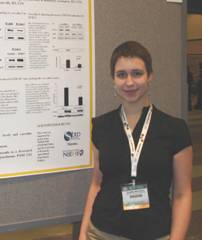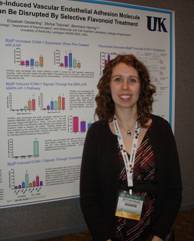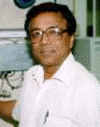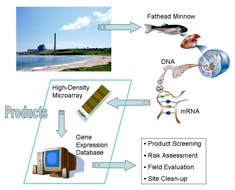 |
||||||
Superfund Basic Research ProgramSBRP-alumnae, Anne Spuches, Ph.D., Presents Research Results on Arsenic Toxicity 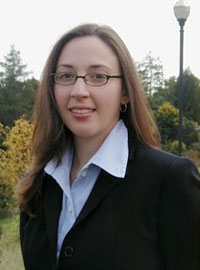 Former SBRP Dartmouth graduate student and Wetterhahn awardee, (http://www.niehs.nih.gov/research/supported/s brp/training/training6.cfm) Dr. Anne M. Spuches, (http://www.niehs.nih.gov/research/supported/s brp/training/training6_s7.cfm) will be presenting her current research at the NIEHS weekly environmental health science series, Frontiers in Environmental Science. Currently, Dr. Spuches is not only an assistant professor at East Carolina University's Department of Chemistry, but also manages her laboratory, while conducting research focused on arsenic toxicity. Dr. Spuches' September 19, 2008 lecture (10 am), "Mechanisms of Arsenic Toxicity: A Thermodynamic and Spectroscopic Investigation of Arsenite and Monomethylarsenite Binding to Small Thiols and the DNA Binding Domain of Glucocorticoid Receptor," will be hosted by Dr. William Suk, M.P.H., at the NIEHS Rodbell Conference Center, Building 101. Recently, Dr. Spuches' research showed that MMA is capable of displacing zinc from the DNA binding domain of the Glucocorticoid receptor, while inorganic arsenite causes no change. These results correlate to studies that show that MMA is more potent and toxic than inorganic arsenic. Her Dartmouth College colleagues, who are SBRP-funded, are also working on the full length protein, and have identified the same result as seen in Spuches work. In the future, Dr. Spuches hopes to learn why MMA is so potent. UK SBRP Director Receives Fulbright Award (http://www.uky.edu/Research/Superfund/News/He nnigFulbright0908.html)  The University of Kentucky's SBRP Program Director, Bernhard Hennig (http://tools.niehs.nih.gov/sbrp/people/detail s.cfm?Person_ID=4366&searchTerm=hennig) , Ph.D., received a Fulbright Award to encourage collaborations between the University of Kentucky and the Universidad de Antioquia in Medellin, Colombia. This upcoming spring (2009), Dr. Hennig will spend four months in Columbia teaching a nutritional biochemistry course and sharing his research expertise. He hopes this will be the start of an official exchange program between the academic units of the two universities. Currently, Dr. Hennig is a professor of nutrition and toxicology in the UK College of Agriculture's Department of Animal and Food Sciences; he has joint appointments in the Center for Nutritional Sciences, the Graduate Center for Toxicology, the Center for Membrane Sciences, and the Gill Heart Institute. Dr. Hennig serves as the primary investigator for the SBRP Project, Superfund Chemicals, Nutrition, and Endothelial Cell Dysfunction, which focuses on the utilization of tissue culture model systems in the study of nutrition and atherosclerosis. His research emphasizes the role of nutrients on biochemical and molecular mechanisms of vascular endothelial cell function, injury, and protection Dartmouth Workshop Sets Research Agenda for Environmental Mercury In November 2006, members of Dartmouth's Toxic Metals Research Program convened a group of 43 scientists to set research priorities and a biomonitoring agenda related to how mercury moves through the marine ecosystem and into the fish that we eat. The workshop, "Fate and Bioavailability of Mercury in Aquatic Ecosystem and Effects on Human Exposure (http://www.niehs.nih.gov/news/events/pastmtg/ 2006/mercury/index.cfm) ", took place in Durham, NH, with funding provided by the NIEHS SBRP and support from the New Hampshire SeaGrant Program. The workshop focused on three major themes:
This month (August 2008), co-authors Celia Chen, research associate professor of biology at Dartmouth, and Nancy Serrell, director of outreach at Dartmouth, released the research agenda from the 2006 workshop, in the current online issue of Environmental Health Perspectives, "Methylmercury in Marine Ecosystems: From Sources to Seafood Consumers - A Work Group Report (http://www.ehponline.org/docs/2008/11211/abst ract.html) Future efforts related to the accumulation of mercury in the environment include convening workshops to compile and evaluate existing mercury data in marine environments and seafood. Louisiana State University (LSU) SBRP Chemist Isolates Air Pollutants 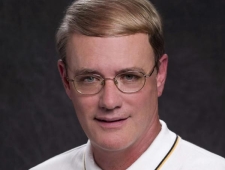
Louisiana State University (LSU) SBRP grantee and environmental chemistry professor, Barry Dellinger, Ph.D., received the prestigious Astellas USA Foundation Award for his scientific contributions related to improving public health research. The award was presented to Dr. Dellinger at the Presidential Symposium of the 236th National Meeting of the American Chemical Society (http://portal.acs.org/portal/acs/corg/content ?_nfpb=true&_pageLabel=PP_TRANSITIONMAIN&node _id=859&use_sec=false&sec_url_var=region1) Dr. Dellinger also presented his research on "environmentally persistent free radicals" (PFRs) at the ACS meeting. His research presentation explained how PFRs are pollutants in the form of microscopic particles that are released into the atmosphere from any flame-producing chemical reaction. Due to the environmental effects of combustion, Dellinger believes that this study could potentially demonstrate why so many non-smokers get lung cancer and other pulmonary diseases. More research is needed before such cancer cases can be linked to PFRs. Evidence thus far depicts that 500,000 Americans die each year from cardiopulmonary illnesses related to 'fine particle air pollution.' Dr. Dellinger emphasized that health risks related to PFRs do not necessarily come from chemicals, but rather from PFRs formed during the chemical combustion processes. PFRs are formed during any combustion process, for example, the burning of coal, fuel power plants, and wood. Scientists used to believe that PFRs quickly died (in a matter of microseconds), but Dellinger's research shows that many of these pollutants can live for days following combustion, and some survive indefinitely (hence the name "persistent free radicals"). Boston University's (BU) SBRP Promotes Information Sharing and Collaboration The BU SBRP supports the notion that scientific knowledge and tools produced by public programs (such as theirs) should be freely available and accessible. In an effort to stimulate collaborative efforts, and increase the accessibility of research tools, BU's SBRP Research Translation Core (RTC) now provides a list of lab reagents and tools (http://busbrp.org/bu-sbrp-laboratory-reagents -and-tools.html) University of Kentucky Professor Haining Zhu Wins Prestigious Maciag Award (http://www.mpi-evv.com/2008idea/fptemplate/re searchpath/Maciag_Award.htm) 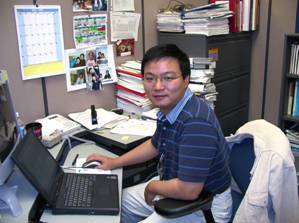
Dr. Haining Zhu (http://www.mc.uky.edu/biochemistry/dept_perso nnel/faculty/zhu.asp) The Maciag award is dedicated to the memory of Thomas Maciag, an internationally recognized cell and vascular biologist. Dr. Maciag was an innovative scientist, artist, outstanding mentor to young investigators, and an excellent educator of graduate students and postdoctoral fellows. The intent of this award is to recognize individuals who exemplify Dr. Maciag's ideals of research excellence and innovation and his commitment to mentoring new scientists. Dr. Zhu will present his research at a special session of the National IDeA Symposium of Biomedical Research (NISBRE) (http://www.mpi-evv.com/2008idea/fptemplate/re searchpath/default.htm) Brown University Professor Featured in Discover Magazine 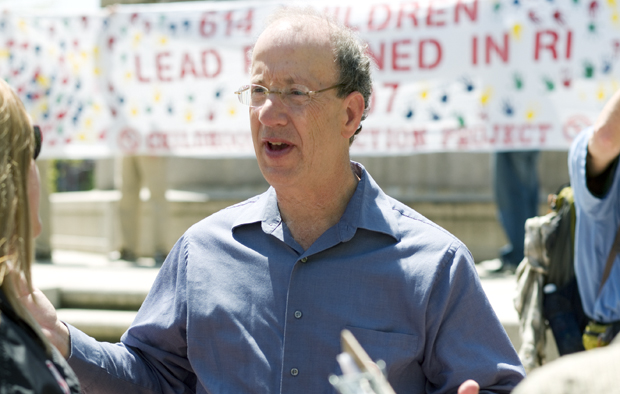
Phil Brown, Ph.D., is a leading sociologist in environmental health, a member of Brown University's (BU) Superfund Basic Research Program (SBRP) Community Outreach (COC) and Research Translation Cores (RTC), and BU professor of medical and environmental sociology. The August (2008) issue of Discover Magazine highlights Brown's contributions as the man who not only coined the term "popular epidemiology," but also continues to raise awareness of environmental contamination in low-income communities. Brown's work focuses on environmental disasters that impact low-income communities, these disasters are typically defined by the neighborhood's long-term health problems, which are inherently caused by toxins. Brown's advocacy for contaminated communities began in Woburn, MA (1984); his efforts continue today, as he perseveres in his efforts to "champion collaborative action(s) between impacted citizens and the scientific community" (Kaplan). Following Brown's experience in Woburn, his academic concentration shifted from mental health to instructing more interdisciplinary classes that focus on medical and environmental sociology, environmental justice, and contested illnesses. Today, Brown continues to lecture at BU, and also assists environmentally impacted communities in the role of advocate or scientist, as needed. Brown is able to utilize his knowledge of political science, toxicology, epidemiology, and sociology, as he applies it to each individual community. More information on Brown's work and influence, The Lifesaving Work of the Man Behind 'A Civil Action' (http://discovermagazine.com/2008/aug/29-the-l ifesaving-work-of-the-man-behind-a-civil-acti on) University of Kentucky (UK) SBRP Researcher to Join EPA IRIS Team 
Xabier Arzuaga, Ph.D., UK SBRP graduate and postdoctoral fellow of Bernhard Hennig's (Ph.D.) Lab, will be joining the U.S. Environmental Protection Agency's (US EPA) Integrated Risk Information System (IRIS) team in Arlington, Virginia. In his new position, Arzuaga will be responsible for the development of multiple concurrent health assessments, while advising EPA's National Center for Environmental Assessment (NCEA), Office of Research and Development's (ORD) staff about scientific issues related to health assessment. The IRIS database contains information on human health effects that may result from exposure to various environmental substances; the system's goal is directed toward individuals who may not have extensive toxicology training, but some knowledge of health science(s). UA SBRP Receives US EPA Pollution Prevention Grant Eric Betterton, Ph.D., Ms. Denise Moreno-Ramirez, and Ms. Monica Ramirez, UA SBRP, in collaboration with Ms. Ann Marie Wolf, Sonora Environmental Research Institute, Inc. (SERI), recently received a US EPA Pollution Prevention (P2) grant. The purpose of the P2 is to help reduce the amount of hazardous substances entering the environment, conserve energy and water, and improve the community's environmental health. The UA SBRP Project Coordinators for the Research Translation and Community Outreach Cores (RTC/COC) see this grant as a product and confirmation of their Outreach diligence. With SBRP funding, both UA's SBRP and the Binational Center programs were able to build trust with the promotoras (health outreach workers), and support initial nurturing and partnership building with SERI and CASA. Project Coordinator, Monica Ramirez, stated: "Our goal is to effectively communicate the science generated from the UA SBRP and Binational Center. We are now partners with strong conduits in the community who are disseminating and utilizing the science of our program to educate others...[We] are building upon a foundation that we have built with the community, which is crucial to carry out the goals of RTC/COC." SERI and the UA SBRP will use the P2 to continue developing the Community Assist of Southern Arizona (CASA), emphasizing a P2 program for businesses. UA's SBRP has been instrumental in CASA's development; they have served on the advisory board, provided toxicology and environmental science training for promotoras, and technical expertise. With the P2 grant, the UA SBRP will:
UA's Superfund and Binational Center Program Coordinators Launch CampCIENCIAS, June 16-20, 2008 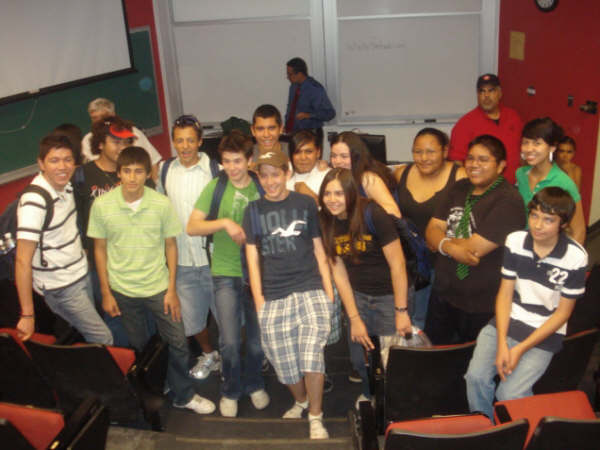
The University of Arizona's SBRP and Binational Center is hosting the first CampCIENCIAS (translated, Camp Science) for 20 high school students living on the United States' side of the Mexico border. The concept for this program began with three Latina scientists/program coordinators from UA: Denise Moreno (SBRP & Binational Center), Rocio Estrella (Binational Center), and Monica Ramirez (Binational Center & SBRP). The students' week-long CampCIENCIAS agenda will include several science-learning activities, in which students will gain skills in science, technology, engineering, and math through hands-on experiences and mentoring sessions with UA undergraduate students. CampCIENCIAS participants were selected as a result of personal essays, which focused on their lives and the reasons they wanted to attend Camp Science. Ramirez, Moreno, and Estrella first presented CampCIENCIAS to their mentor and Binational and SBRP program director, Dr. A. Jay Gandolfi. He whole-heartedly supports the trio's goals and aspirations for their community education efforts. With this vote of confidence, the three then applied and received a grant from the UA Technology and Research Initiative Funds (TRIF) via the Water Sustainability Program. The grant will cover the tuition, room and board for the 20 students. Dr. Bruce Hammock Receives UC Davis' Distinguished Teaching Award 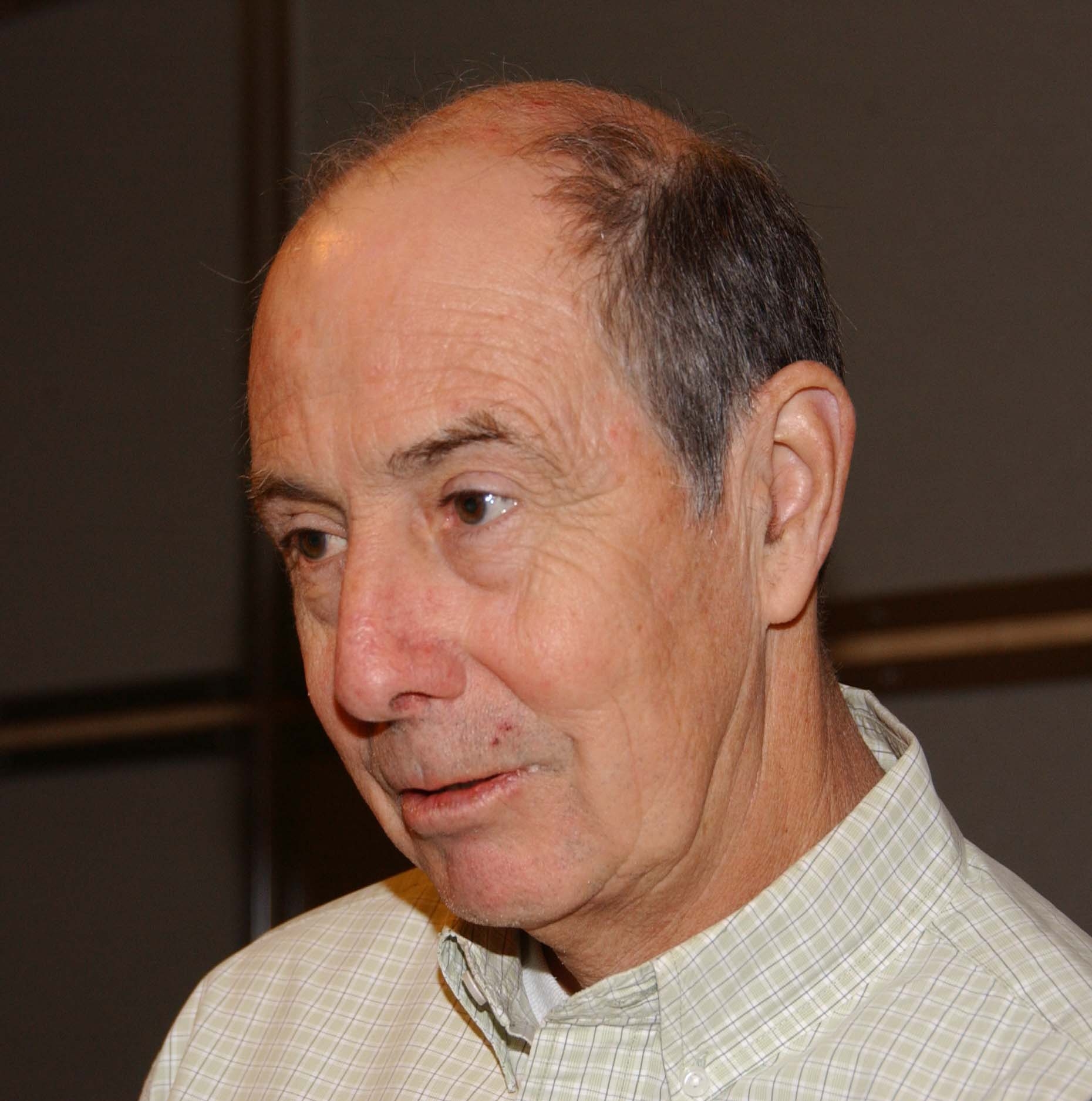
Each year the Academic Senate of the University of California, Davis (http://www.ucdavis.edu/index.html) Hammock receives this award as recognition for his active involvement and dedication to his students, his interdisciplinary research, and his scientific and professional career guidance. Students and professors perceive him as a "campus icon," says Lynn Kimsey, Chair of the Department of Entomology. "Despite his international reputation and his many commitments, he remains accessible and generously spends hours training and educating students and other professionals..." Versatile, multidisciplinary, scientific, passionate, committed, collaborative, teacher, mentor, interactive...these have all been words that students and faculty have used to describe the well-rounded and much admired professor at Davis. Hammock's laboratory functions on numerous interdisciplinary levels, with diverse projects that combine basic, applied, and physical sciences. This distinct environment gives students and international scientists an intellectually enriching and stimulating setting, while providing them with a realistic look at skills that are desired and/or careers that are available in the current job market. His lab serves as home to both the NIEHS SBRP and the NIH Training Grant in Biomolecular Technology. In the past five years, Hammock has hosted more than 40 postdoc fellows/senior scientists, and awarded six doctoral degrees and two master's degrees. Currently, he has seven doctoral students working in his lab, and continues to help train future entomologists, biochemists, engineers, chemists, and biologists. Dr. Walter Leal, Professor and former Chair of the Department of Entomology, best summarizes why Hammock deserves this recognition by UC Davis' Academic Senate, "[He] is that unique individual who sparks the interest of students, holds it, and helps them succeed." SBRP Scientists at Duke Reveal TRI Burden Reduction Rule Flaws Duke University scientists, funded by the NIEHS SBRP, recently published their study, "Environmental Justice Implications of Reduced Reporting Requirements of the Toxics Release Inventory (TRI) Burden Reduction Rule," in Environmental Science and Technology. Scientists found that the vast majority of individuals negatively affected by the 2006 EPA TRI Burden Reduction Rule are minority and low-income communities. The TRI was first introduced to the public in 1986. It protected public communities, health and safety officers, workers, and regulators by alerting them about the presence and/or use of chemicals in, around, or near their living or working vicinity. The altered 2006 TRI Burden Reduction Rule was a rule created to exempt some industries from reporting detailed information about the toxic chemicals they released. Marie Lynn Miranda, director of the Children's Environmental Health Initiative (CEHI) at Duke University, and associate professor at the Nicholas School of the Environment, along with her team, used a distance-based geographic information system (GIS) spatial analysis to examine the racial and socioeconomic characteristics of communities with one kilometer, three kilometer, and five kilometer buffers around exempt and non-exempt facilities. Miranda et. al's results were found to be in discord with the EPA's interpretation of its national analysis. She said that the overall results for those communities within "proximity to industrial facilities [that are] no longer required to report detailed information about their chemical releases, have significantly higher percent minority, minority under the age of five and low-income populations compared to communities where all the information is still available...there was also significant differences in these demographics between regions and at the state level." For the more information on Miranda's research, her publication is available at Environmental Science and Technology (http://pubs.acs.org/cgi-bin/abstract.cgi/esth ag/asap/abs/es7028119.html) Brown University's SBRP Develops Disposal Mechanism for CFLs 
Dr. Robert Hurt, professor of engineering, Brown University, and senior engineering student, Natalie Johnson, helped lead Brown's SBRP research team in the development of an innovative mechanism to safely help in the disposal of compact fluorescent lamps (CFLs). This break-through is crucial because CFLs contain a small amount of vaporous neurotoxin mercury, which releases vapor when the bulb is discarded. The vapors emitted from the bulb pose serious health risks to infants, children, and pregnant women. The Brown University teams of SBRP scientists, engineering students, and Steven Hamburg, associate professor of environmental studies, have collaborated to construct two prototypes using the mercury absorbent materials discovered by Johnson and Hurt. The two prototypes developed: a mercury-absorbent package, which will be placed inside the store-bought CFL package, and plastic bags that are specifically designed to soak up the mercury vapors when the CFLs are thrown away. In early 2008, Brown University applied for federal patents for both the mercury absorption packaging and the absorbent material, nanoselenium. In the near future, the university hopes to talk with potential companies that are interested in manufacturing the new technology. UA: SBRP and U.S. Binational Center Coordinate Promotora Training The UA SBRP and the Binational Center teams helped coordinate the "Fundamentals of Toxicology" workshop for the Community Assist of Southern Arizona and Tucson Unified School District promotoras (community health advocates) on April 19, 2008. The workshop's objective was to increase the promotoras' level of understanding in the fields of toxicology and epidemiology from both Mexican and American academic perspectives. The half day training session was taught by Drs. A. Jay Gandolfi (toxicology) and Mercedes Meza (epidemiology); Ms. Rocio Estrella served as the event translator. As part of the training, participants received copies of the presentations and take-home materials to help reinforce what they learned. Most importantly, the promotoras interacted with a number of UA faculty and staff, so as to encourage communication and expand their professional information resources. This new and unique training program demonstrates UA's Binational Center and the SBRP's goal to bridge the gap between the scientists and the public. University of Arizona's SBRP Hosts International Conference on Mine Tailings The University of Arizona, College of Pharmacy's Superfund Basic Research Program (UA SBRP) hosted an international workshop to address mine tailings on June 5-6, 2008. The workshop's 48 global experts converged to discuss health impacts and novel approaches to handle problems related to mine tailings in arid environments. According to the UA SBRP, inactive and abandoned mine tailing disposal sites are prevalent in arid and semiarid regions of the world. Monica Ramirez, a member of the workshop's steering committee and coordinator for the UA SBRP Research Translation Core, commented that these "mine tailing sites can have profound health and environmental consequences." NIEHS (a major sponsor to the workshop) funds the UA SBRP. The school's SBRP goal is to "investigate the hazardous waste and public health issues currently confronting the Southwestern region of the United States, specifically arsenic, chlorinated hydrocarbon, and mine tailings contamination." Workshop discussions will help prepare a collaborative white paper journal article with recommendations and results from the meeting. UK Students Shine at the Society of Toxicology Conference Zuzana Majkova and Elizabeth (Beth) Oesterling represented the University of Kentucky's SBRP Labs at the 2008 Society of Toxicology (SOT) Conference in Seattle, WA. Both were awarded travel awards for their research in the laboratory of Dr. Bernhard Hennig. SOT recognized Zuzana's research efforts for her novel studies in examining the role of caveolae in PCB-mediated toxicity. At the conference, Zuzana presented her poster, "Endothelial Cell Caveolae are Involved in Activation of Aryl Hydrocarbon Receptor Pathway by Coplanar Polychlorinated Biphenyls." Her research demonstrates that certain diet-derived compounds can down-regulate caveolin-1 levels and caveolae function. She is currently exploring the possibility of using a diet enriched in dietary n-3 PUFAs to modulate endothelial caveolae and possibly prevent cardiovascular toxicity. This research can potentially help in uncovering dietary therapies for PCB-exposed populations, and help develop primary prevention strategies of diseases associated with a variety of environmental toxic insults.
Presently, Zuzana is finishing her Certificate in Environmental Systems, which will allow her to approach environmental problems from a broader perspective. She will graduate for UK in the spring of 2009 with a Ph.D. in Toxicology. Beth received a travel award from SOT for her research on the interaction of flavonoids with hydrocarbons. At the Seattle conference, she presented her poster, "Benzo[a]pyrene-Induced Vascular Endothelial Adhesion Molecule Expression Can Be Disrupted By Selective Flavonoid Treatment." Her research focuses on the polycyclic aromatic hydrocarbon, benzo[a]pyrene (B[a]P), and its role in endothelial cell dysfunction in the vasculature. Beth's research also supports the objective of the UK-SBRP, which is the incorporation between nutrition and exposure to environmental toxins that lead to disease. She is investigating the role of flavonoids, dietary polyphenolic compounds enriched in fruits and vegetables, in their protection against B[a]P induced vascular diseases; thus far, she notes that select flavonoids will protect against B[a]P induced ICAM-1 expression. Nutrition may provide the most sensible means to develop intervention and prevention strategies of diseases associated with many environmental toxic insults, and can also be used as models for pharmacological interventions. Another research project that Beth is working on is a collaborative project between Dr. Hennig's laboratory (biomedical science specialization lab) and the laboratory of Dr. Bachas (chemical and physical sciences). Jointly, the labs investigate the toxicity of manufactured alumina nanoparticles to the vascular endothelium. Nanoparticles are a billion dollar commercial industry, but, in the recent past, numerous concerns have been raised as to whether these materials are safe. With help of Dr. Chopra (Dr. Bachas' lab), Beth demonstrates that alumina nanoparticles, which comprise 20% of the nanoparticles produced worldwide, can increase the expression of a number of cellular adhesion molecules and increase the activation of the endothelium in an in vitro system. The collaborative nature of the University of Kentucky SBRP grant continues to allow these labs to investigate multiple sides of this complicated problem. Presently, Beth is finishing her Ph.D. in Toxicology and will graduate this summer. She hopes to work for the EPA in North Carolina with focuses on the application of research and risk assessment. Shortage of Medical Scientists Fosters Innovative UCSD Summer Course La Jolla, CA — This summer the University of California, San Diego (UCSD) will host an intensive three week course in Systems Pharmacology and Translational Biology. The course will run from July 7-25, and will be open to no more than 20 participants, including advanced graduate students, post-docs, recent Ph.D. recipients working in academia, and biotech/pharmaceutical industry employees. UCSD in conjunction with sponsors, NIGMS and NIMH, and in cooperation with NIH, created this program in response to the noted shortage of medical scientist with training in organ system physiology and pharmacology, and the analysis of organ system function in drug development. This three-week course will focus, specifically, on the central nervous system, cardiovascular system, and its autonomic regulation, in addition to recent techniques for imaging organ function. By the end of the session, the participating institutions would like to have participants familiar with specific target phenotypes and processes; give students a training experience with a variety of mouse imaging techniques; train participants in assessing phenotype on genetically altered animals; familiarize students with the use of animals and organ systems in the development of new drugs; teach students responsible and ethical conduct of research and the use of animal subjects; and provide opportunities to analyze and present lab findings (stressing quantitative methods and basic pharmacology principles). Applications are due June 1st. Participants are responsible for room, board, and travel; however, UCSD is arranging for campus housing availability for participants, $29 per day. Specific application directions and materials can be accessed on the UCSD Webpage (http://superfund.ucsd.edu) Note, this course is not intended to provide re-training for those in the job market, but, rather, it is intended for the applicant categories already mentioned. UK-SBRP Researchers Receive Great Teacher Awards
Since1961, the University of Kentucky (UK) Alumni Association (AA) Great Teacher Award (http://www.uky.edu/Research/Superfund/News/Gr eatTeacherAwards02_08.html) Dr. Bhattacharyya is a University Alumni Professor and the Director of Graduate Studies for Chemical and Materials Engineering. His research and publications focus on membrane separation/functionalization, tunable membranes and biocatalysis, and dechlorination of hazardous organics by nano-structured metals. His work with the UK-SBRP seeks to develop and implement versatile technologies for the effective dechlorination of hazardous organics utilizing both oxidative and reductive pathways. Dr. Lisa Gaetke is Associate Professor in the School for Environmental and Human Sciences. She conducts research and is widely published on nutrition, medical nutrition therapy, and community nutrition as it relates to environmental contaminants. As Outreach Core Leader, Dr. Gaetke directs UK-SBRP's Superfund Community Action through Nutrition (SCAN) program and helps impacted communities and health care providers utilize nutritional interventions to improve health outcomes following exposure to environmental contaminants. Society of Toxicology Honors Dean E. Carter, Former UA-SBRP Director Former University of Arizona (UA) SBRP Director, Dr. Dean E. Carter, received the 2008 Society of Toxicology's (SOT) Metals Specialty Career Achievement Award at the SOT's annual conference in Seattle, Washington (March 16-20). Dr. Carter served as a researcher, mentor, and leader in the field of metal toxicology with special emphasis on arsenic. When Dr. Carter worked with the UA-SBRP, he helped develop many successful multi-disciplinary approaches to Superfund issues. Dr. Carter, in collaboration with Dr. A. Jay Gandolfi, developed the U.S.-Mexico Binational Center for Environmental Studies (BCES) program; the two teamed up with a third colleague, Dr. M. Cebrian-Garcia (Mexico). For two decades Dr. Carter helped with work related to binational health issues. He is also credited with the NIEHS' strong support for the BCES program. Dr. Carter emphasized that health on the borders is environmental, i.e., it is "a long-term problem that requires a long-term solution." In addition to these accomplishments, Dr. Carter is recognized as a major influence to young and advancing scientists. Moreover, Dr. Carter's influence goes beyond the sphere of academia (educating, training, and mentoring students), as he revolutionized regulatory and risk assessment decisions related to metal toxicology. EcoArray, Inc. Fosters the Development of a Powerful Fish Gene Database
EcoArray, Inc. combines the expert construction of arrays along with fish gene data, so as to develop products that will test the response of fish genes to environmental stimuli. Superfund Basic Research Program (SBRP) Small Business Innovation Research (SBIR), Phases I and II grants helped EcoArray develop, validate, and market large oligonucleotide-based glass microarrays for fathead minnows and largemouth bass, which, in turn, fostered the development of a powerful fish gene database. (Note, the launch of the chips developed in compliance with the SBRP SBIR grant, and other ‘complementary products,’ were launched beginning in 2006.) Building upon EcoArray’s notable progress in the realm of microassay development, they received the EPA-SBIR Phase I Grant to continue research to identify the gene response (in minnows) following exposure to carbon nanotubes. This research will then be added to the fish gene database and analyzed to determine the affected [metabolic] pathways, which will help identify the “genetic fingerprints,” and help validate the expediency and affordability of using high density fathead microarrays for compound screening and use in determining environmental toxicity. EcoArray’s ultimate goal is to determine the negative and/or adverse effect(s) that nanomaterials could have on human health by using the fish gene database as a tool to interpret human health issues. Andrew Lynch Receives Prestigious Gates Cambridge Scholarship Graduating senior, Andrew Lynch, a chemical engineering major from the University of Kentucky (http://www.uky.edu/Research/Superfund/News/Ly nchAward02_08.html) Andrew is the first UK student to receive this highly prestigious and competitive scholarship, which will cover the full-cost of his graduate study and research in any subject available at Cambridge. In accepting the Gates Cambridge Scholarship, Lynch turned down full-ride offers from the Massachusetts Institute of Technology, Stanford University, California Institute of Technology and Princeton University. Throughout his four years at UK, Andrew not only managed to consistently maintain a 4.0 GPA, but was also a Beckman Scholar (undergraduate research in biology and chemistry), and a researcher in Dr. D.B. Bhattacharryra's lab. Andrew served as an assistant to the NIEHS-SBRP's research project related to chelate modified free radical reaction for TCE destruction. Lynch was the first to investigate the novel use of ion exchange beads to entrap Fe(II) for subsequent free radical formation through the use of H2O2. Developing "Smart" Materials for Business and Industry
from The Lane Report (http://www.kybiz.com/reports/RKy08_final_lo.p df) Biologists and chemists from the University of Kentucky's (UK) College of Arts and Sciences are developing new strategies to integrate cell and protein recognition, function, and motion to build nanoscale architectures through business and industry applications. The nanotechnology research teams of Drs. Leonidas Bachas and Sylvia Daunert (Department of Chemistry) have combined their efforts to develop "smart" biomaterials, substances that can sense a stimulus and react to it in a useful, reliable, reproducible, and reversible manner. The combined groups are supported by over $1.5 million a year in federal funding. The UK's research groups are also focusing on biomaterials that integrate proteins within hydrogels, i.e., jelly-like substances that swell or shrink in the presence of a target compound. The swelling or shrinking action of these nanomaterials is important and can potentially translate into applications, such as the fabrication of microlenses for integration into analytical instrumentation for pharmaceutical, environmental, clinical, and biotechnology industries. Other new research items include polymers that open and close valves in devices, microfluidics systems for use in analysis and diagnostics, and responsive drug delivery systems. These applications can potentially be available to the public within the next five years, although the microlenses might appear earlier. Daunert believes that the sensors and microlenses will, most likely, give the Kentucky economy the biggest boost. SBRP Scientist, Kathy Senekeo-Effenberger Awarded the James R. Gillette Drug Metabolism Best Paper of 2007 SBRP scientist, Kathy Senekeo-Effenberger, formerly of Dr. Robert Tukey's Laboratory (http://tools.niehs.nih.gov/sbrp/programs/Prog ram_detail.cfm?Project_ID=P42ES103370004) at the University of California-San Diego (UC-San Diego), was awarded the James R. Gillette Drug Metabolism Best Paper of 2007 by the Awards Selection Committee of the Drug Metabolism Division of the American Society of Pharmacology and Experimental Therapeutics (ASPET). Effenberger's research,"Expression of the human UGT1 locus in transgenic mice by 4-chloro-6-(2,3-xylidino)-2-pyrimidinylthioactetic acid (WY-14643) and implications on drug metabolism through peroxisome proliferator-activated receptor α activation" was a collaboration of her work with laboratory colleagues (S. Chen, E. Brace-Sinnokrak, J.A. Bonzo, M.-F. Yueh, U., Argikar, J. Kaeding, J. Trottier, R.P. Remmel, J.K. Ritter, O. Barbier and R.H. Tukey), and published in Drug Metabolism and Disposition (http://dmd.aspetjournals.org/cgi/content/abst ract/35/3/419) As part of this prestigious award, Effenberger will present her group's research at the Experimental Biology Meeting (http://www.eb2008.org) At the UC-San Diego Tukey Laboratory work continues to further characterize the cellular events that will lead to the regulation of the UGT1 locus. According to Effenberger, work continues on the recently developed Ugt1 null mouse model and its implementation to create a humanized UGT1 mouse model, which should help examine the regulation and role of human UGT1A proteins in vivo.  |
||||||


